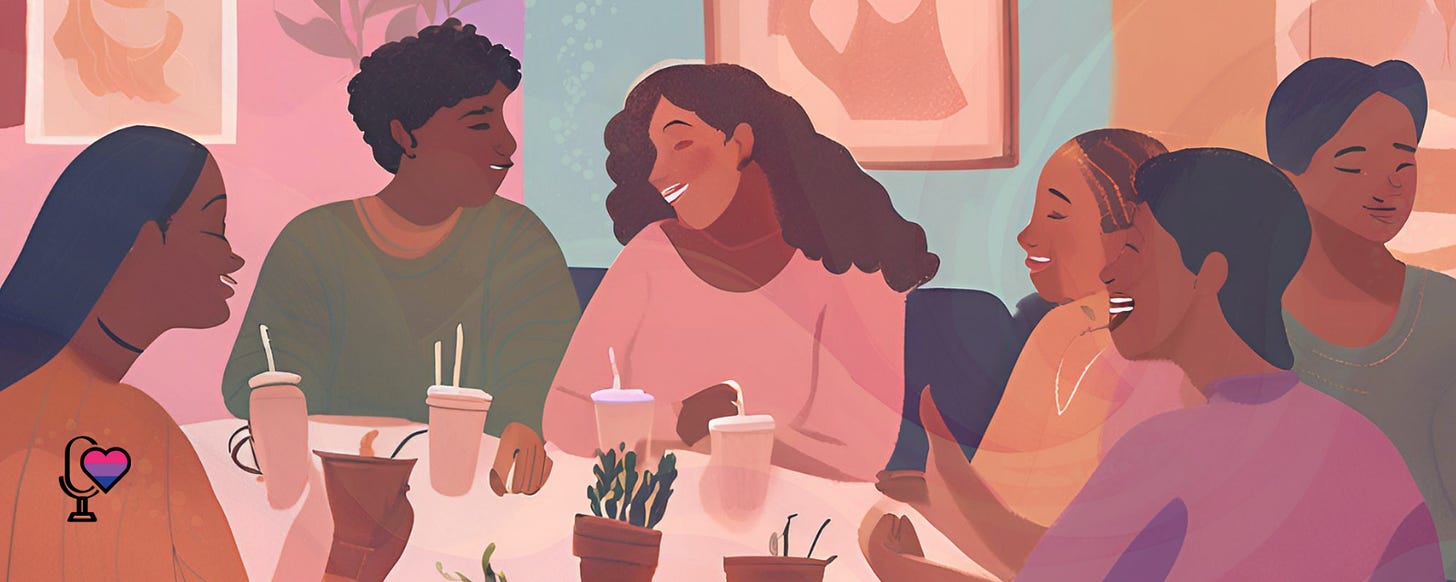Who Gets to Be Bisexual?
Fostering an expansive community benefits all. Period. That's the post.
When we talk about gatekeeping in the bi+ community, the most obvious form often comes from outside: society's incessant demand for us to justify our existence, explain our identities, or prove that we're “queer enough.” But as a fellow bi+ listener recently reminded us, some of the deepest wounds can come from within our own community. The harsh gatekeeping imposed on bi+ spaces—the rigid boundaries of who "counts" as bisexual, biromantic, or bi+—creates harm we rarely discuss.
For our peers who carry both ace and bi+ labels, the message sent by some spaces is clear: you don’t belong here unless you also experience sexual attraction. For those whose attractions don’t fit conventional patterns, there’s often an unspoken demand to conform or risk being dismissed. These exclusions reveal a troubling irony: in the community most equipped to embrace fluidity, there are those who have recreated the same rigid frameworks we sought to escape.
Let’s unpack how gatekeeping manifests within the bi+ community itself and explore how we can address the harm it causes—not just for bi-ace (a base, if you will) folks but for all of us.
Gatekeeping in Bi+ Spaces
Gatekeeping within the bi+ community often hides behind the language of legitimacy. For example, there’s a tendency to center bisexuality as an identity defined by sexual attraction, marginalizing those whose experience of being bi+ might not include sexual attraction at all.
This harms bi+ folks who may not experience sexual attraction or are still making sense of the sexuality part in their bi+ness by implying they’re not “queer enough” to claim space within bi+ communities. It also narrows the understanding of bisexuality, reducing it to a single axis of experience and ignoring the vast, multi-faceted ways we relate to attraction.
But it doesn’t stop there. Bi+ gatekeeping also shows up in the exclusion of:
Non-binary people who are told they don’t “count” as part of someone’s multi-gender attraction.
BIPOC folks who experience racism layered on top of bi+ erasure, both in broader queer spaces and within our own community.
Disabled bi+ people may find their experiences dismissed because of ableist assumptions about their capacity for attraction or relationships.
People in monogamous relationships, particularly those partnered with opposite-gender individuals, are seen as “less queer” because their queerness isn’t immediately visible.
This gatekeeping mirrors the same forces of exclusion we all face outside the community: erasure, invalidation, and a refusal to honor the complexity of our identities. This is a kind of assimilation strategy that actively ignores what queerness is: disruptive, fluid, and ever-changing.
The Impact of Internal Gatekeeping
The harm of gatekeeping runs deep. For many bi-ace, it creates a sense of alienation from a community that should feel like home. Instead of finding solidarity, they encounter skepticism, dismissal, or outright hostility.
This exclusion also reinforces harmful hierarchies, implying that some ways of being bi+ are more valid or authentic than others. It’s not just bi-ace people who suffer; anyone whose experience of bisexuality deviates from an unspoken norm risks being seen as less than.
Moreover, internal gatekeeping undermines the strength of our movement. The bi+ community’s greatest power lies in its diversity—we’re united not by a single way of being but by a shared commitment to resisting binaries and embracing complexity. Every person we push away weakens that foundation.
Moving Toward an Inclusive Bi+ Community
So how do we do better? How do we ensure that bi+ spaces are inclusive of all who fall under this beautifully broad umbrella?
Redefine the Center
It’s time to move away from centering bisexuality solely on sexual attraction. Historically speaking, bi+ spaces have been inclusive of all kinds of liminality, including gender and gender expression. As we remember our roots, let’s embrace a more inclusive definition that honors romantic, aesthetic, and other forms of attraction—or even the absence of attraction—as equally valid ways to be bi+.
Amplify Marginalized Voices
Listen to those most often excluded from bi+ spaces: bi-ace folks, BIPOC bi+ people, disabled bi+ people, and others. Their perspectives aren’t just valuable—they’re essential to building a community that reflects our diversity.
Challenge Your Assumptions
Ask yourself: What assumptions am I making about what it means to be bi+? Where might those assumptions come from? How did I learn them? How can I unlearn them?
Create Spaces for All Experiences
Not all bi+ spaces will meet every need, but we can ensure a range of spaces exist. For example, bi-ace folks shouldn’t have to fight for inclusion in general bi+ spaces—they should also have the space and warmth that allows them to thrive.
Focus on Connection, Not Policing
If someone identifies as part of the bi+ community, that’s enough. Instead of gatekeeping, focus on fostering connection: What do we have in common? How can we support each other? How can we move forward together?
Building a Community of Belonging
Gatekeeping asks, “Who gets to be bisexual?” Inclusivity reframes the question: “How do we create a bi+ community where everyone feels like they belong?”
When we challenge internal gatekeeping, we don’t just make space for bi-ace folks—we make space for everyone whose experience of being bi+ doesn’t fit the narrow definitions we’ve inherited. We make space for complexity, growth, and solidarity.
We owe it to ourselves and to each other to build a community where every bi+ person feels seen, valued, and safe. After all, isn’t that what drew us here in the first place? Let’s ensure it’s what keeps us here, too.
xoxoxo,
Your Favorite Bisexual Killjoys
Bailey & Jace



